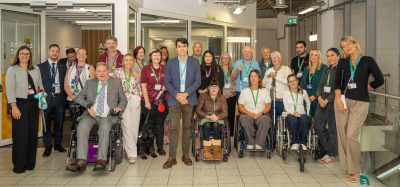Insights on air navigation services and innovations in UAE
Posted: 8 August 2024 | Ahmed Al Jallaf | No comments yet
Ahmed Al Jallaf, Assistant Director General of Air Navigation Services at the UAE General Civil Aviation Authority (GCAA), speaks to International Airport Review about how his organisation is looking to modernise airspace, drive technological change and innovation and entice the next generation into the industry.


Firstly, could you tell us a little bit about yourself and your role?
My name is Ahmed Al Jallaf. I’m in charge of the UAE GCAA air navigation services provider. I’ve been doing this since 2011. UAE aerospace is amongst the busiest and highest-density airspaces in the world. The traffic complexity is very high and I’m very passionate about aviation. I’m blessed with team members striving for excellence and achievements, which makes my job much easier.
You led the UAE Airspace Restructuring Project back in 2017. Can you tell us a little about the project and its results?
The project was unique since the establishment of the UAE flight information region (FIR) in 1986. The traffic had grown significantly, and previous enhancements created fragmentation rather than serving our customers’ needs and national expansion plans. We needed a collaborative approach involving 26 stakeholders from government, private, commercial, military and international organisations. In 2017, we successfully achieved significant fuel burn savings and CO2 emissions reductions, adding value and enhancing capacity to accommodate today’s traffic growth. Others in the region have followed our lead, restructuring their airspace as well.
This project took place seven years ago. How are you pushing this even further as airspace management continues to evolve?
In 2023, we experienced a double-digit traffic growth and in the first two months of 2024, we saw a 12% increase. We are now initiating the next phase of our integrated airspace master plan. A dedicated working group is reviewing requirements based on recent traffic growth figures. We expect to start working on the next phase by the end of this year or early next year.
Recently, you led a delegation to Madrid for the next generation ATM system project. Can you tell me about this and its significance?
We identified enhancements in aerospace restructuring and advanced technology. The next generation air traffic management system is our future ATM system; it’s scheduled for implementation in early 2025. We are in the final stages of testing and validating the system, which will support our air traffic controllers in delivering state-of-the-art services to stakeholders and airspace users.
How are you working to ensure sustainable flight paths for your airlines?
Part of our 2017 airspace restructuring project was to implement designs that save fuel burns and reduce CO2 emissions. Since then, we’ve invested in continuous descent and climb operations, further reducing fuel burn and emissions. In July 2023, we implemented the Middle East’s first free route airspace, achieving significant fuel savings and CO2 reductions. We’ve also signed an MOU with Etihad Airways and Thales to initiate the Green Flag initiative for sustainable operations. 2024 has been designated the Year of Sustainability in the UAE, and we are exploring advanced technology and airspace design to secure more sustainable results.
How are you collaborating with other entities to improve ATM in the UAE?
Experience has taught us that working in isolation leads to fragmented solutions. We design solutions in collaboration with stakeholders, ANSPs, airlines, and airports to ensure they meet users’ needs. Regionally, we work with adjacent ANSPs and international organisations like ICAO and IATA on projects benefitting the region, as the UAE is part of a broader network requiring mature and productive co-operation for optimal results.
What technology do you think will disrupt the industry in the next few years?
Technology is constantly evolving. Currently, there’s a focus on artificial intelligence, blockchain and machine learning. The UAE is pioneering in these areas, with dedicated ministries and universities. However, deploying AI in aviation, a safety-critical industry, comes with challenges like cyber-security. AI and advanced technologies will be deployed more in non-technical operational areas initially. The private sector needs to lead acceleration programmes to meet cyber-security and aviation needs. Global and regional buy-in is necessary for developing standards and regulations for such technologies.
Many airports have innovation hubs. Is this typical for ANSPs or are they lagging behind?
During the Dubai Airshow, we signed a multi-party agreement to initiate the UAE ATM Innovation Lab that will be located in Abu Dhabi near the airport. I’m optimistic about this lab being an opportunity for the UAE and the region to develop new solutions addressing our regional challenges.
Your vision is to create leaders for tomorrow. How are you championing the next generation of leaders?
The UAE invests heavily in developing future leaders. I’m an Emirati who is passionate about the vision and the views of our leaders: our leaders have invested in the next generation at a very early age. We have the GCAA Leadership Programme to identify and empower future leaders with the right knowledge and experience. We also participate in multiple UAE government leadership programmes. Additionally, we have the GCAA Youth Council and the UAE Aviation Youth Council, comprising of young individuals, passionate and empowered by our leadership to understand aviation challenges and become future leaders.
You mentioned being a product of this vision yourself. Could you explain?
I took on my current role at the age of 31, the youngest globally in such a position. I graduated from the Mohammed Bin Rashid Leadership Development Programme, a government initiative preparing future leaders.
Women comprise only 20.6% of air traffic controllers globally. Are you working on initiatives to improve this number in the UAE?
The UAE gives significant attention to women. We have nine female Ministers in the cabinet, doing excellent work. We have female pilots and controllers. Our nationalisation programme for air traffic control is open to both genders. Although more females are now applying, their dropout rate is higher due to various reasons, including family and performance. We continue promoting the profession and encouraging female participation.
About the interviewee
Ahmed Al Jallaf is the Assistant Director General Air Navigation Services at the UAE General Civil Aviation Authority. He was amongst the first UAE nationals to validate as an Air Traffic Controller in 2000. Ahmed holds an MSc degree in Aviation Safety Management. He has led many successful projects. The most notable is the UAE Airspace Restructuring Project implemented in 2017, which resulted in a significant increase in airspace capacity to cater to future global air traffic demands.
He was awarded the prestigious 2018 Aviation Executive of the Year Award at the Aviation Business Awards. In 2019, he completed the “Impactful Leaders Program” from the Mohammed bin Rashid Center for Leadership Development (MBRCLD), whose vision is to “create leaders for tomorrow.” His passion for aviation drives him to innovate and constantly aim to raise the bar in this field. He is the Chairman of the UAE National Airspace Advisory Committee, GCC Air Navigation Committee, and the ICAO MID Air Navigation Planning & Implementation Group.
New report from International Airport Review: Securing Airports in an Evolving Threat Landscape
International Airport Review has brought together top voices from across the global aviation security sector, including International Civil Aviation Organization (ICAO), ACI World, Fraport, Qatar Civil Aviation Authority, Winnipeg Airports Authority, and Smiths Detection to examine today’s most pressing airport security challenges and emerging threats.
This expert-led report provides a strategic assessment of the vulnerabilities facing airports in 2025, encompassing cyber-attacks, drone incursions, evolving geopolitical risks, and emerging technologies.
The result is a practical, insightful guide to strengthening airport resilience, anticipating risks before they escalate, and keeping your airport off the front page
Download the report for free and stay ahead of the security curve – READ FOR FREE NOW!
Related topics
Airspace modernisation, Digital transformation, Emissions, Innovation, New technologies, Sustainability, Workforce



















